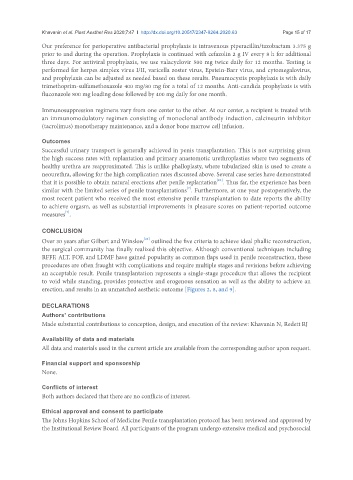Page 544 - Read Online
P. 544
Khavanin et al. Plast Aesthet Res 2020;7:47 I http://dx.doi.org/10.20517/2347-9264.2020.63 Page 15 of 17
Our preference for perioperative antibacterial prophylaxis is intravenous piperacillin/tazobactam 3.375 g
prior to and during the operation. Prophylaxis is continued with cefazolin 2 g IV every 8 h for additional
three days. For antiviral prophylaxis, we use valacyclovir 500 mg twice daily for 12 months. Testing is
performed for herpes simplex virus I/II, varicella zoster virus, Epstein-Barr virus, and cytomegalovirus,
and prophylaxis can be adjusted as needed based on these results. Pneumocystis prophylaxis is with daily
trimethoprim-sulfamethoxazole 400 mg/80 mg for a total of 12 months. Anti-candida prophylaxis is with
fluconazole 800 mg loading dose followed by 400 mg daily for one month.
Immunosuppression regimens vary from one center to the other. At our center, a recipient is treated with
an immunomodulatory regimen consisting of monoclonal antibody induction, calcineurin inhibitor
(tacrolimus) monotherapy maintenance, and a donor bone marrow cell infusion.
Outcomes
Successful urinary transport is generally achieved in penis transplantation. This is not surprising given
the high success rates with replantation and primary anastomotic urethroplasties where two segments of
healthy urethra are reapproximated. This is unlike phalloplasty, where tubularized skin is used to create a
neourethra, allowing for the high complication rates discussed above. Several case series have demonstrated
[61]
that it is possible to obtain natural erections after penile replantation . Thus far, the experience has been
[7]
similar with the limited series of penile transplantations . Furthermore, at one year postoperatively, the
most recent patient who received the most extensive penile transplantation to date reports the ability
to achieve orgasm, as well as substantial improvements in pleasure scores on patient-reported outcome
[7]
measures .
CONCLUSION
[22]
Over 30 years after Gilbert and Winslow outlined the five criteria to achieve ideal phallic reconstruction,
the surgical community has finally realized this objective. Although conventional techniques including
RFFF, ALT, FOF, and LDMF have gained popularity as common flaps used in penile reconstruction, these
procedures are often fraught with complications and require multiple stages and revisions before achieving
an acceptable result. Penile transplantation represents a single-stage procedure that allows the recipient
to void while standing, provides protective and erogenous sensation as well as the ability to achieve an
erection, and results in an unmatched aesthetic outcome [Figures 2, 8, and 9].
DECLARATIONS
Authors’ contributions
Made substantial contributions to conception, design, and execution of the review: Khavanin N, Redett RJ
Availability of data and materials
All data and materials used in the current article are available from the corresponding author upon request.
Financial support and sponsorship
None.
Conflicts of interest
Both authors declared that there are no conflicts of interest.
Ethical approval and consent to participate
The Johns Hopkins School of Medicine Penile transplantation protocol has been reviewed and approved by
the Institutional Review Board. All participants of the program undergo extensive medical and psychosocial

